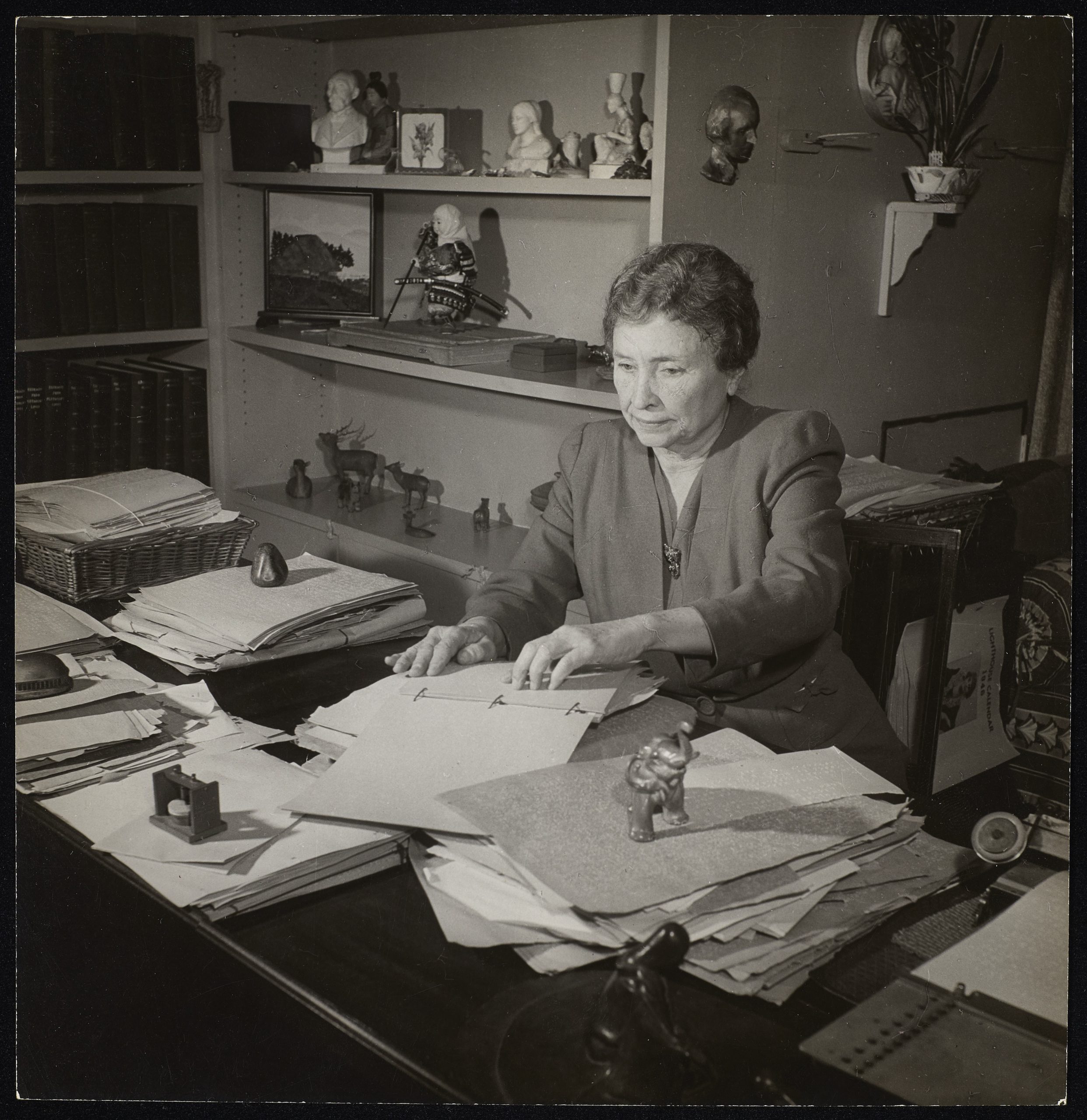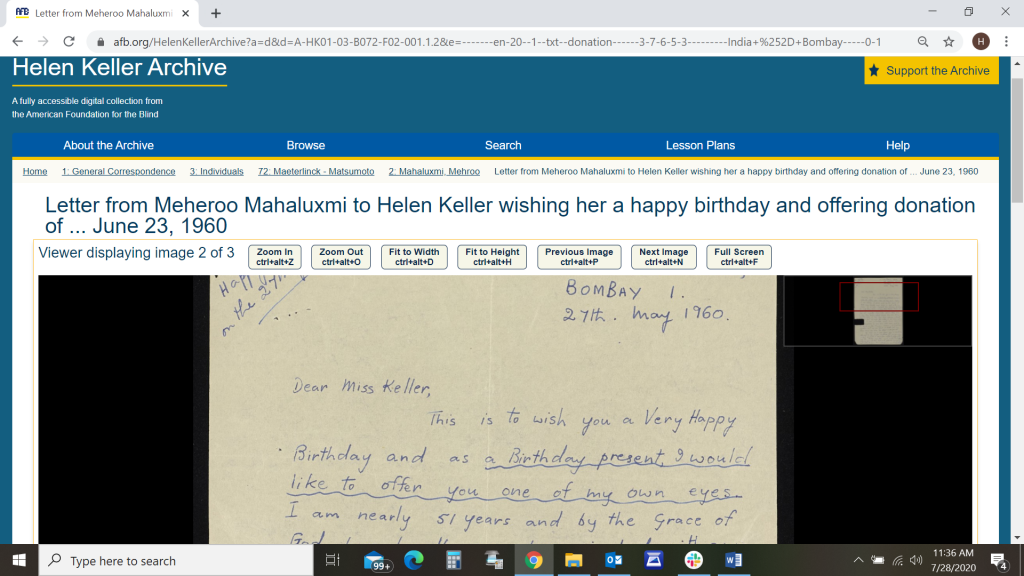
“He who is content with what has been done is an obstacle in the path of progress.”
-Helen Keller, 1927
For too long, disability history has been overlooked and has remained inaccessible to our own communities. The digital Helen Keller Archive enables students with disabilities to see themselves in history, and to shape that history through unmediated, independent research. Equally, it is important for sighted and hearing children to learn about the achievements of disabled people.
In 2015, with a grant from the National Endowment for the Humanities, the American Foundation for the Blind (AFB) began the herculean task of digitizing the largest collection of materials by and about deafblind activist and lecturer Helen Keller (1880-1968). Our main goal was to make the online archive fully accessible to people who are blind, deaf, deafblind, and hard of hearing. Through careful use of image descriptions, captions, and audio description—in addition to fully compliant code, well-labeled controls, and extensive user testing—we believe AFB has pioneered the most accessible online archive currently available.
This great start led us to our next goal: to use this unique resource to bring disability history into the classroom.
In 2019, AFB began developing free lesson plans to teach middle and high school students about Keller’s life, disability history, and the use, function, and value of digital archival collections. This post will describe the curricula creation process, including testing with teachers and students, and underscores the importance of educational resources that enable disabled students to access their own history.
The Helen Keller Archive
Helen Keller was among the most recognizable disabled people in the twentieth century. She used her extraordinary popularity not only as an advocate for disabled people, but was also as a feminist, social activist, and public intellectual. Keller’s involvement in key cultural, social, and political events of the nineteenth and twentieth centuries was unparalleled. She was both a product of her environment and a driving force upon it, paving the way for a more inclusive society. Her advocacy resulted in legislation that benefited blind students and veterans and had profound ramifications. Modern scholars such as Georgina Kleege have confronted issues resulting from her iconic status and her “elevation” as a disabled person, and have reflected on problematic aspects of her legacy. Regardless, Keller remains a significant figure in disability history worldwide.
AFB’s Helen Keller Archive contains over 186,000 digital images, as well as thousands of pieces of metadata spanning from Keller’s birth in 1880 to 1986, eighteen years after her death. Materials include correspondence, speeches, essays, press clippings, scrapbooks, photographs, films, and artifacts—including materials from nine U.S. presidents, and leading figures such as Mark Twain, Pearl S. Buck, and Albert Einstein. The archive also contains letters to Keller from ordinary men, women, and children around the globe, whose stories have never been told. Few collections can deliver such a wealth of primary and secondary source materials chronicling twentieth century history. Our challenge was figuring out how to maximize the educational potential of the collection.



What Do Teachers Want?
In January 2019, we asked Helen Keller Advisory Board Committee: “What educational features should we develop for the Helen Keller Archive?” They responded, quite wisely, “Ask the teachers.” That led us to create a focus group with educators at the Math & Science Exploratory School, MS 447, in Brooklyn to find out what tools they needed to bring the Helen Keller collection into their classrooms.
Key themes for the lesson plans emerged, in support of specific Common Core curriculum standards. Recommended topics included:
- learning about digital and physical archives
- developing internet research skills, including how to use primary and secondary sources
- exploring disability rights and civil rights in Keller’s lifetime
We created a team that included a project manager with experience creating curricula for museums, a curricula writer, an historian and college professor, our digitization vendor, AFB staff with accessibility expertise, and myself, the archivist. Over six months we hashed out our draft lesson plans, and in December 2019, sixty eighth-grade sighted and hearing students at Brooklyn’s MS 447 helped AFB beta-test the first lesson: Introduction to Digital and Physical Archives, which we had originally piloted at the New York Institute for Special Education, Bronx, NY, with students who were blind and low vision.
The curricula team observed how an experienced teacher adapted the lesson to fit available class time. It was fascinating to listen to students discuss the importance of preserving information, and the pros and cons of physical and digital archival collections. Some students had never heard of Helen Keller, while others had in-depth knowledge of her as a political advocate.
Difficulties with the “Search” and “Browse” features revealed the need for usability improvements, as well as greater emphasis on teaching digital research skills. The students were fascinated by accessibility and wanted to learn more about how people who are blind, deaf, and deafblind access multimedia content. We plan to create a short video showing disabled students navigating the website with assistive technology.
Distance Learning and Students with Disabilities
In June 2020, we launched our first two lessons: Introduction to Digital and Physical Archives and Primary and Secondary Sources. These lessons are available on the Helen Keller Archive website and will be included on other educational sites, such as the NEH: EDSITEment.neh.gov
Little did we expect that a global pandemic would underscore the importance of accessible online lesson plans for distance learning. In-person testing of the lesson plans was scheduled to take place earlier this year with visually impaired students at the New York Institute for Special Education in the Bronx, NY, but of course had to be postponed indefinitely due to COVID-19 school closures. In the meantime, we have recorded the first lesson so that students may follow along, guided by a “virtual” teacher. The video lesson incorporates audio description, captions, and transcripts so that all information has a text equivalent to ensure access for students and teachers who are blind, low vision, Deaf, deafblind, or hard of hearing.
Centennial of Women’s Suffrage
With 2020 marking the centennial of the 19th Amendment in the U.S, we were thrilled to receive a grant from Humanities New York (HNY) to create a lesson devoted to Helen Keller and women’s suffrage using the digital archive. This was a golden opportunity to use the archive’s documents to teach students how to contextualize historical events.
For instance, Keller gave a speech at a 1916 women’s conference in Chicago in support of women’s suffrage. This speech provides contemporaneous reporting on the fight for equal representation. Students can discuss historical events concerning the creation of a more equitable society, and relate them to today’s actions to do the same.
As we developed the third lesson, we realized that we needed to address issues of race, class, and gender to provide broader context for Keller’s role in the suffrage movement. We connected with teachers and academics of African-American history to review the draft for sensitivity purposes and historical accuracy.
As the Americans with Disabilities Act turned 30 on July 26, 2020, we urge all organizations to make their collections fully accessible. We hope to collaborate with other organizations to create a disability history consortium. A portal containing multiple accessible digital collections will amplify the power of archives to disseminate histories long ignored.
In the meantime, remember that every time you create a digital record, or share an item online, you are either including or excluding users with disabilities, based on your approach. Please provide descriptions and text equivalents for images, video, and audio, and follow web content accessibility guidelines. It’s crucial that we make disability history fully available to all.

–Helen Selsdon is the project director for a National Endowment for the Humanities-funded initiative to digitize and make accessible Helen Keller’s archival collection. From 2002 – 2019 Selsdon oversaw the care of AFB’s historical collections including the Helen Keller Archive, the Talking Book Archive, the AFB Archive, and the M. C. Migel Rare Book collection. Selsdon can be reached at hselsdon@afb.org.
Header: Helen Keller is reading text in braille. She is seated at her desk at her home in Westport, Connecticut, 1950. Helen Keller Archive.
Further Reading
“Miracle Work” Reflections of a French Deafblind Scholar on the Digital Helen Keller Archive
Accessibility of the Helen Keller Archive
Georgina Kleege, Blind Rage: Letters to Helen Keller (Washington, D.C.: Gallaudet University Press, 2006).
Kim E. Nielsen, The Radical Lives of Helen Keller (New York: New York University Press, 2009).